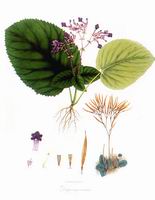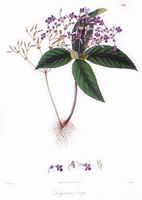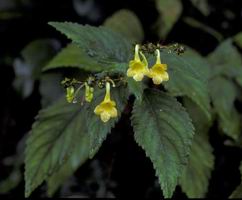
Didymocarpus macrophyllus D.Don (4-7),
Wall., Pl. Asiat. rar. 2, t. 141 (1831), both as D. aromaticus
Full name and orig. publication: Didymocarpus Wall., Edinburgh Phil. J. 1: 378 (1819), nom. cons.
Etymology: From the Greek διδυμος, didymos = twin; and καρπος, karpos = fruit, in reference to the the two valves of the capsular fruit, each of them being (seemingly) bilocular by the recurved placentae.
Synonyms: ? Gyrocheilos W.T.Wang (1981).
Infrafamilial position: Didymocarpoid Gesneriaceae - "Advanced Asiatic and Malesian genera" (Weber 2004).
Description: Perennial terrestrial or saxicolous, caulescent herbs. Stems seasonal, herbaceous, erect, with few nodes; renewal buds being produced in the humid season, surpassing the dry season and developing to flowering shoots in the next humid season. Leaves decussate, usually two (to several) pairs born on top of stem. In Malayan species several distant pairs. Cymes axillary, pedunculate, few- to many-flowered. Sepals free to base or connate in the lower half. Corolla usually straight tubular or trumpet-shaped, widening towards the mouth; limb slightly to strongly bilabiate, rarely personate, lobes rounded; colour usually claret-coloured or violet, in the Malayan species also white or yellow. Stamens 2, filaments slender; anthers cohering. Nectary cup-shaped, rim sometimes lobed. Ovary cylindrical, stigma capitate. Fruit a usually stipitate, bivalved capsule, dehiscing loculicidally.
Chromosome number: 2n = 22, 24, 28, 32, 36, 44, 54, 56.
Species number: Over 70.
Species names (incl. publication and synonyms): See Skog, L.E. & J.K. Boggan. 2005: World checklist of Gesneriaceae: http://persoon.si.edu/Gesneriaceae/Checklist.
Type species: Didymocarpus primulifolius D.Don
Distribution: From N and NE India, Nepal and S China southwards to the Malay Peninsula and N Sumatra.
Ecology: On damp (usually acid) rocks or earth banks, in forest or above the forest line, (rarely) sea level to 3500m.
Notes: The genus was redefined by Weber & Burtt (1998d) and restricted to an essentially Sino-Himalayan alliance extending southwards and reaching the everwet tropics with a few species. According to Wang & al. (1998) 31 spp. occur in China, but some have to be removed from the genus (Weber & al. 2000). In the Malay Peninsula and N Sumatra there is an overlap with the spp. of Henckelia, that were formerly included in Didymocarpus. From Henckelia, Didymocarpus is distinguished by the fruit (a usually stipitate, orthocarpic-bivalved capsule vs. plagiocarpic-follicular capsule), the habit (seasonal growth pattern with monocarpic shoots developing from an underground rhizome or rootstock), floral features (e.g., polished cartilaginous texture of sepals, corolla mostly tubular or trumpet-shaped and claret-coloured) and chromosome numbers (variable, but not n = 9 as in Henckelia, Kiehn & al. 1998). A part of the species included by Wang & al. (1990, 1998) in Didymocarpus, with acaulescent habit and orbicular or reniform leaf blades (D. heucherifolius-alliance, placed by Wood 1974 in Chirita) must be removed (Weber & al. 2000).
Selected references: Wang et al. in Wu & Raven (eds.), Fl. China 18: 349-358 (1998), reg. rev.; Weber & Burtt, Beitr. Biol. Pflanzen 70: 293-363 (1998, "1997"), emend.; Weber, Burtt & Vitek, Ann. Naturhist. Mus. Wien 102 B: 441-475 (2000), materials for rev.; Hilliard, in Grierson & Long, Fl. Bhutan 2(3): 1308-1315 (2001), reg. rev.; Burtt, Thai Forest Bull. (Botany) 29: 81-109 (2001), annot. checklist, new spp. (Thailand).
Bibliography: See Skog, L.E. & J.K. Boggan. 2005. Bibliography of the Gesneriaceae. 2nd edition: http://persoon.si.edu/Gesneriaceae/Bibliography.
Illustrations:
 |
Didymocarpus primulifolius D.Don (1-3),
type species Didymocarpus macrophyllus D.Don (4-7), Wall., Pl. Asiat. rar. 2, t. 141 (1831), both as D. aromaticus |
 |
Didymocarpus oblongus D.Don
Wall., Pl. Asiat. rar. 2, t. 140 (1831) |
 |
Didymocarpus citrinus Ridl.
Penins. Malaysia, Gunung Jerai, phot. A.Weber (1984) |
last modified: 2007-07-13